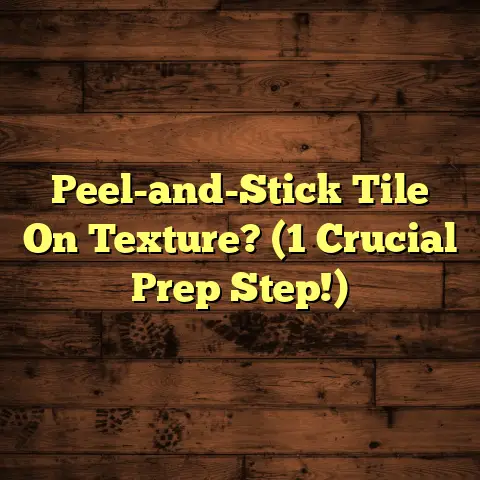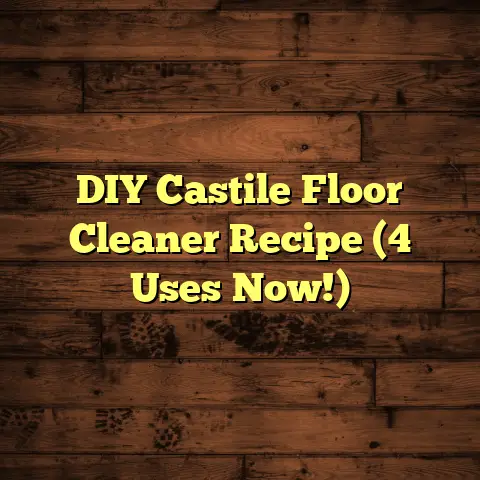Tile Floor Cleaner With Brushes: Tips (2 Secrets!)
Have you ever noticed how a tile floor can transform from a sleek surface to a sticky dance floor in the blink of an eye?
It’s almost as if those tiny tiles conspire to collect every crumb, spill, and smudge, turning our homes into a miniature version of a messy kitchen battlefield!
As a flooring contractor with years under my belt, I’ve seen it all – from the aftermath of toddler art projects to the silent horror of pet accidents.
And let me tell you, the right tile floor cleaner, combined with the perfect brush, is your secret weapon in this never-ending war against grime.
So, grab a cup of coffee, and let’s dive into the nitty-gritty of keeping those tiles sparkling!
Understanding Tile Flooring
Okay, let’s get one thing straight: not all tiles are created equal. We’ve got ceramic, porcelain, stone (like marble, granite, and slate), and more.
Each type has its own personality, and therefore, its own cleaning needs. Ceramic is the workhorse, relatively low-maintenance and can handle most cleaners.
Porcelain, its tougher cousin, is denser and less porous, making it more resistant to stains.
Stone tiles, on the other hand, are the divas of the flooring world. They require gentle care and specific pH-neutral cleaners to avoid damage.
But here’s the kicker: it’s not just about the tile itself. The grout – that often-neglected space between the tiles – is a breeding ground for dirt, mold, and mildew.
Think of it like this: you can have the shiniest tiles in the world, but if your grout looks like it belongs in a horror movie, your whole floor is going to look… well, horrifying.
Maintaining the grout and seams is just as crucial as cleaning the tile surface.
Why? Because a clean grout line not only looks better, but it also prevents long-term damage to your subfloor by keeping moisture out.
The Role of Tile Floor Cleaners
Now, let’s talk about the arsenal you have at your disposal. Tile floor cleaners come in all shapes and sizes: liquid, spray, concentrated…
It can be overwhelming, right? Liquid cleaners are your standard option, often diluted in water for mopping. Sprays are great for spot cleaning those “oops, I spilled my coffee” moments.
Concentrated cleaners are the powerhouses, designed to be diluted for extra cleaning oomph.
But here’s where things get interesting: no matter how powerful your cleaner is, it can only do so much on its own. That’s where the trusty brush comes in.
Think of the brush as your cleaning assistant, your partner in crime against dirt and grime.
A good brush can enhance the cleaning process by ensuring deeper penetration into grout lines and textured surfaces.
I’ve seen so many homeowners simply swiping at their floors with a mop, leaving behind a thin layer of dirty water.
It’s like taking a shower without soap – you might feel cleaner, but you’re not really getting rid of the grime. Brushes help to agitate the dirt, lifting it away from the surface so it can be easily wiped away.
Tip 1 – The Power of Dual-Action Cleaners
Okay, here’s the first secret I want to share with you: dual-action cleaners. These are game-changers.
Imagine a cleaner that not only dissolves dirt and grime but also has a built-in scrubbing brush.
It’s like having a mini cleaning crew at your fingertips. I’m talking about products like the Grout Brush with Built-in Squeeze Bottle Cleaner (available on platforms like Amazon).
These cleaners typically come in a bottle with an attached brush head. You squeeze the bottle to release the cleaning solution while simultaneously scrubbing the surface.
It’s efficient, effective, and saves you from having to lug around a separate bucket and brush.
Here’s a step-by-step guide on how to effectively use these products:
- Preparation: Clear the area of any loose debris, like crumbs or pet hair. A quick sweep or vacuum will do the trick.
- Application: Squeeze the bottle to release the cleaning solution onto the tile and grout. Don’t overdo it – a little goes a long way.
- Scrubbing: Use the attached brush to scrub the grout lines and tile surface in a circular motion. Apply moderate pressure, focusing on areas with stubborn stains.
- Wiping: Use a clean, damp cloth or mop to wipe away the dirty solution. Rinse the cloth or mop frequently to avoid spreading the grime.
- Drying: Allow the floor to air dry completely. You can speed up the process by using a fan or opening windows.
I remember one time, a client of mine had a seriously grimy kitchen floor. She had tried everything – mops, sponges, you name it. Nothing seemed to work.
I recommended a dual-action cleaner with a built-in scrubbing brush. A week later, she called me, practically singing my praises. She couldn’t believe how easily the cleaner removed years of built-up grime.
She said her floor looked like it had been professionally cleaned, and she saved a ton of money doing it herself.
That’s the power of a good dual-action cleaner!
Tip 2 – The Art of Brush Selection
Now, for the second secret: brush selection. I can’t stress this enough: not all brushes are created equal.
Using the wrong brush can be like trying to cut steak with a butter knife – frustrating and ineffective.
You’ve got stiff bristle brushes, soft bristle brushes, electric scrubbers, and everything in between.
So, how do you choose the right one?
- Stiff Bristle Brushes: These are your heavy-duty cleaners, perfect for tackling stubborn stains and grime on durable surfaces like ceramic and porcelain. They’re also great for scrubbing grout lines. Just be careful not to use them on delicate stone tiles, as they can cause scratching.
- Soft Bristle Brushes: These are your gentle giants, ideal for cleaning delicate surfaces like marble and other natural stone tiles. They won’t scratch or damage the surface, but they may not be as effective on tough stains.
- Electric Scrubbers: These are the power tools of the cleaning world. They come with a variety of brush heads and pads, making them versatile for different cleaning tasks. They can save you a lot of elbow grease, but they can also be expensive.
Here’s a quick guide on which brushes work best for various tiles and stains:
| Tile Type | Stain Type | Brush Type |
|---|---|---|
| Ceramic | Grease, Dirt | Stiff Bristle |
| Porcelain | Wine, Coffee | Stiff Bristle |
| Stone (Marble) | Water Spots, Mildew | Soft Bristle |
| Grout | Mold, Mildew | Grout Brush |
For example, if you have a porcelain tile floor with stubborn coffee stains, a stiff bristle brush will be your best bet.
But if you have a delicate marble floor with water spots, a soft bristle brush is the way to go.
I once made the mistake of using a stiff bristle brush on a client’s marble floor. Let’s just say it wasn’t pretty. The brush left visible scratches on the surface, and I had to spend hours buffing them out. Lesson learned: always choose the right brush for the job!
Common Tile Cleaning Mistakes to Avoid
Alright, let’s talk about some common pitfalls I see homeowners fall into all the time.
Avoiding these mistakes can save you time, money, and a whole lot of frustration.
- Using the Wrong Products: This is a big one. Using acidic cleaners on stone tiles can cause permanent damage. Always read the label and make sure the product is safe for your tile type.
- Over-Scrubbing: Sometimes, less is more. Over-scrubbing can damage the tile surface and grout lines. Use moderate pressure and let the cleaner do its job.
- Neglecting Grout Maintenance: As I mentioned earlier, grout is often overlooked. Regular grout cleaning and sealing can prevent stains and mold growth.
- Using Dirty Water: This is like washing your car with a dirty sponge. It just spreads the grime around. Always use clean water and rinse your mop or cloth frequently.
- Not Drying the Floor: Leaving the floor wet can lead to water spots and mildew growth. Always dry the floor thoroughly after cleaning.
I had a client who used bleach to clean her stone tile floor. She thought it would kill the mold and mildew. Instead, it etched the surface of the tiles, leaving them looking dull and discolored.
She ended up having to replace the entire floor, a costly mistake that could have been avoided by using the right products.
DIY Tile Floor Cleaner Recipes
Now, if you’re feeling adventurous, you can try making your own tile floor cleaner.
DIY recipes are often more eco-friendly and can save you money. Here are a couple of my favorites:
- Vinegar and Water: Mix equal parts white vinegar and warm water in a spray bottle. This is a great all-purpose cleaner for ceramic and porcelain tiles. Just be careful not to use it on stone tiles, as vinegar is acidic and can damage the surface.
- Baking Soda Paste: Mix baking soda with enough water to form a thick paste. Apply the paste to stubborn stains and let it sit for a few minutes before scrubbing with a brush. This is a great natural abrasive for removing tough grime.
- Dish Soap and Water: Add a few drops of mild dish soap to a bucket of warm water. This is a gentle cleaner that’s safe for most tile types.
Here’s a table comparing the benefits of natural vs. commercial cleaners:
| Feature | Natural Cleaners | Commercial Cleaners |
|---|---|---|
| Eco-Friendliness | High | Low |
| Cost | Low | High |
| Effectiveness | Good for Mild Stains | Good for Tough Stains |
| Safety | Generally Safe | Can Contain Harsh Chemicals |
I’ve been using a vinegar and water solution to clean my own ceramic tile floors for years. It’s cheap, effective, and doesn’t leave any harsh chemical odors.
Maintaining a Routine
Okay, so you’ve got your dual-action cleaner, your perfect brush, and your DIY recipes.
Now what? The key to keeping your tile floors looking their best is to establish a regular cleaning routine.
Think of it like brushing your teeth – you wouldn’t skip it for weeks, would you?
Here’s a suggested cleaning schedule:
- Daily: Sweep or vacuum to remove loose debris.
- Weekly: Mop with a mild cleaner.
- Monthly: Deep clean grout lines with a brush.
I know, it sounds like a lot of work. But trust me, a little bit of maintenance goes a long way.
By establishing a routine, you can prevent grime from building up and make your cleaning tasks much easier in the long run.
Enhancing the Lifespan of Tile Floors
Finally, let’s talk about preventative measures. Protecting your tile floors from damage can extend their lifespan and save you money on repairs.
- Use Mats: Place mats at entrances to trap dirt and moisture.
- Use Furniture Pads: Protect your floors from scratches by placing pads under furniture legs.
- Avoid Harsh Chemicals: As I mentioned earlier, harsh chemicals can damage tile surfaces. Always use cleaners that are specifically designed for your tile type.
- Seal Grout Lines: Sealing grout lines can prevent stains and mold growth.
I had a client who installed beautiful new tile floors in her kitchen. She was so proud of them, but she didn’t take any preventative measures.
Within a few months, her floors were covered in scratches and stains. She ended up having to replace them, a costly mistake that could have been avoided with a little bit of prevention.
Conclusion
So, there you have it: my top tips for keeping your tile floors sparkling clean. Remember, the right tile floor cleaner with brushes, combined with a regular cleaning routine and preventative measures, is your key to success.
And don’t forget the two secrets:
- The Power of Dual-Action Cleaners
- The Art of Brush Selection
If cleanliness is next to godliness, then a well-maintained tile floor is surely the VIP lounge of the home!
Now go forth and conquer those dirty tiles! You’ve got this!





